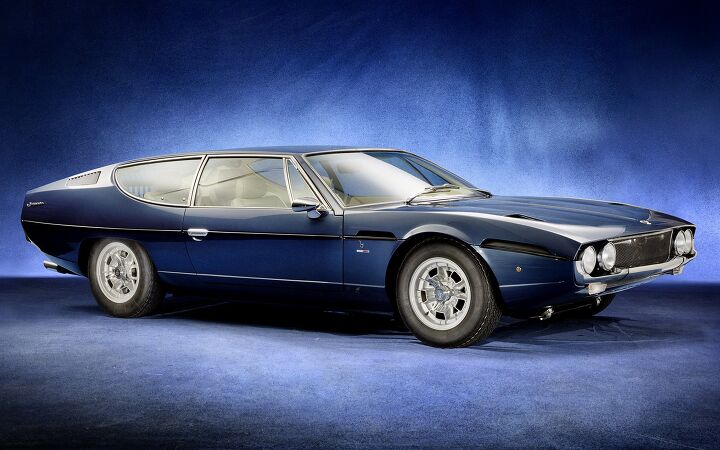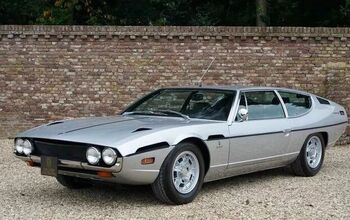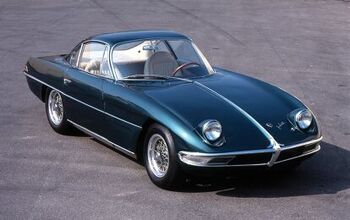Rare Rides Icons: Lamborghini's Front-Engine Grand Touring Coupes (Part IX)

We return to our timeline of front-engine Lamborghini GT coupes, but take a step back in time. Our last entry left us at the conclusion of 1969 when the slow-selling Islero ground to a halt. Dealers had a difficult time shifting all 225 examples of the Islero, comprising 125 regular Isleros and 100 of the upgraded Islero S.
Ferruccio Lamborghini dictated the Islero’s restrained and elegant design to Mario Marazzi, after several concepts to replace the aged 400GT did not meet with the boss’s approval. What Lamborghini was really after was a four-seat grand tourer in the finest tradition of grace and pace. The Islero fit most of those qualifications, but was a 2+2 and (as mentioned) almost impossible to sell. Luckily, there was another front-engine Lamborghini GT that debuted at almost the same time as Islero in 1968. Say hello to Espada.
The Espada was the ultimate distillation of the ridiculous Marzal concept of 1967, as penned by Marcello Gandini at Bertone. While Ferruccio declared at its debut the Marzal was just a fun and affordable PR boost, the design made an impact nonetheless. Behind the scenes, Lamborghini was in talks with Bertone to rework the design into something more down to earth. Ferruccio was keen on the four-seat GT idea, and Gandini was the first person who showed him an exciting coupe in said format.
However, the Marzal was not the only concept Bertone displayed in 1967. From stage left, Jaguar and a British newspaper editor enter the scene. Around the same time Lamborghini asked Bertone for a four-seat concept, a man by the name of John Antsey also called the Italian coachbuilder. Antsey was the auto editor of the Daily Telegraph in the UK, and he had a keen interest in a new concept coupe as well.
Antsey wanted to showcase what the British car building industry (already well into its decline) could do, so he naturally called Italy. He’d already secured the chassis and running gear from a contemporary Jaguar E-Type from founder Sir William Lyons, but wanted an exotic looking body. The project was not sponsored by Antsey, but rather by the Daily Telegraph which apparently had money to burn.
Nuccio Bertone (son of company founder Giovanni) ran Bertone at the time, and assigned the design work to one of his younger employees, Gandini. He drafted an all-new direction for a Jaguar and called it the Pirana. With a long and flowing hood, a narrow front end, and large quad headlamps. The Jaguar leaping cat was presented large in the center of the grille, above a thin strip of bumper.
There was a strong lower character line like on the Marzal, but the Pirana was more curvaceous along its leading edge and had a very two-seat window line. Side windows curved upward immediately aft of the B-pillar. The upswept window line led to a huge C-pillar, which framed a large rear windscreen. There were gill details to break up the expanse of metal, and the body character lines headed upward at the rear.
Pirana ended in a near vertical rear end, the upper half of which was covered in a faux black grille. The lower portion had two large, Rover SD1-like brake lamps, supported by another thin chrome bumper. The rear hatch consisted of just the windscreen, which made a high liftover for any luggage.
Pirana (spelled that way by Gandini intentionally) first debuted at the London Motor Show in October 1967 (seven months after Marzal), and was shown later in Italy and New York. Unlike the Marzal, it lacked ridiculous see-through glass doors and a silver metallic interior. The Pirana was grounded much more in reality. The Marzal was also a mid-engine design, while the Pirana was front-engine.
Though it wore its Jaguar badging proudly, the company was firmly rooted in its traditionalism and was not interested in any modern Italian style showcase. After all, it was still selling plenty of the E-Type upon which the Pirana was based. The Pirana was turned over to the Daily Telegraph immediately after its auto show debuts. As it was a newspaper with no need for a concept car, it was sold on to a private party without delay.
Around the time it was clear Jaguar was not going to pick up the Pirana’s design for production, Lamborghini requested a distillation of Marzal. See where this is headed? What Gandini proceeded to do was take the large overall dimensions of the Marzal, and adapt the design of the Pirana to fit. Suddenly, Espada! Save money, save time, everybody’s happy.
The Pirana’s front end was copied over to the Espada with few alterations. Espada used the same open front end, framed by sharp edges of the hood and fenders and had four large lights. The Espada received some driving lamps and indicators, but those were among the only notable front end changes. The wide, flat hood of the Pirana remained intact, though two funnel-shaped air inlets were added for cooling.
Both main Pirana character lines translated over to the Espada. The only difference was the upswept window line, which was a bit slower because the Espada was a four-seater. It headed upward further aft the B-pillar than the Pirana. Even wheel arches (stylish rear wheel arches were a Gandini signature) remained the same between Pirana and Espada.
At a quick glance, it would be easy to confuse the Pirana and Espada from a rear view. Aside from the aforementioned slower upsweep to the side window, the two were almost identical in their proportions. The glass rear hatch of the Espada was slightly smaller than on the Pirana, to account for the second row of seats in the Lamborghini. Other details like the shape of the character lines and how they met the rear end, and the C-pillar vent trims were almost a copy/paste.
The Pirana’s rear grille design was replaced on the Espada by a tinted glass panel, which provided more rear visibility. The rear lamps looked less like Rover lamps as they transitioned to smaller units of a Fiat nature. And the simple chrome bumper of the Pirana was lightly reworked into a hoop design.
Because the Pirana was based on an E-Type, its interior was just as reality-based as its exterior. And as such, most of it carried over to the Espada. The seats of early Espadas were the design shown in the Pirana, as was the steering wheel. The dash layout changed slightly, and adopted the current center console look Lamborghini used at the time. Both cars used plenty of wood trim to signify their GT status. (Note: 1974 Espada shown here.)
Elsewhere on the interior, the Espada had four big captain’s chairs, with legitimate legroom for adults at the rear. The cabin was trimmed in nice leather, which was usually tan but branched into other colors later. Given the generous glass area, the interior was a well-lit, pleasant place to be. The same could not be said for Espada's contemporary, the Islero.
Though it worked out in the end, the styling combination of Marzal and Pirana was not without controversy, as someone in the process was still stuck on gullwing doors. It was also the first large front-engine car Lamborghini made, which presented some interesting engineering issues. We’ll pick up there next time.
Become a TTAC insider. Get the latest news, features, TTAC takes, and everything else that gets to the truth about cars first by subscribing to our newsletter.
[Images: Bertone, Lamborghini, seller]

Interested in lots of cars and their various historical contexts. Started writing articles for TTAC in late 2016, when my first posts were QOTDs. From there I started a few new series like Rare Rides, Buy/Drive/Burn, Abandoned History, and most recently Rare Rides Icons. Operating from a home base in Cincinnati, Ohio, a relative auto journalist dead zone. Many of my articles are prompted by something I'll see on social media that sparks my interest and causes me to research. Finding articles and information from the early days of the internet and beyond that covers the little details lost to time: trim packages, color and wheel choices, interior fabrics. Beyond those, I'm fascinated by automotive industry experiments, both failures and successes. Lately I've taken an interest in AI, and generating "what if" type images for car models long dead. Reincarnating a modern Toyota Paseo, Lincoln Mark IX, or Isuzu Trooper through a text prompt is fun. Fun to post them on Twitter too, and watch people overreact. To that end, the social media I use most is Twitter, @CoreyLewis86. I also contribute pieces for Forbes Wheels and Forbes Home.
More by Corey Lewis
Latest Car Reviews
Read moreLatest Product Reviews
Read moreRecent Comments
- Probert They already have hybrids, but these won't ever be them as they are built on the modular E-GMP skateboard.
- Justin You guys still looking for that sportbak? I just saw one on the Facebook marketplace in Arizona
- 28-Cars-Later I cannot remember what happens now, but there are whiteblocks in this period which develop a "tick" like sound which indicates they are toast (maybe head gasket?). Ten or so years ago I looked at an '03 or '04 S60 (I forget why) and I brought my Volvo indy along to tell me if it was worth my time - it ticked and that's when I learned this. This XC90 is probably worth about $300 as it sits, not kidding, and it will cost you conservatively $2500 for an engine swap (all the ones I see on car-part.com have north of 130K miles starting at $1,100 and that's not including freight to a shop, shop labor, other internals to do such as timing belt while engine out etc).
- 28-Cars-Later Ford reported it lost $132,000 for each of its 10,000 electric vehicles sold in the first quarter of 2024, according to CNN. The sales were down 20 percent from the first quarter of 2023 and would “drag down earnings for the company overall.”The losses include “hundreds of millions being spent on research and development of the next generation of EVs for Ford. Those investments are years away from paying off.” [if they ever are recouped] Ford is the only major carmaker breaking out EV numbers by themselves. But other marques likely suffer similar losses. https://www.zerohedge.com/political/fords-120000-loss-vehicle-shows-california-ev-goals-are-impossible Given these facts, how did Tesla ever produce anything in volume let alone profit?
- AZFelix Let's forego all of this dilly-dallying with autonomous cars and cut right to the chase and the only real solution.










































Comments
Join the conversation
Espada is one of those that can look pretty odd in photos, but is gorgeous in person. I wasn't aware of its Jag origins, and frankly translated better as the final product.
My favorite Lamborghini. Espada > Miura